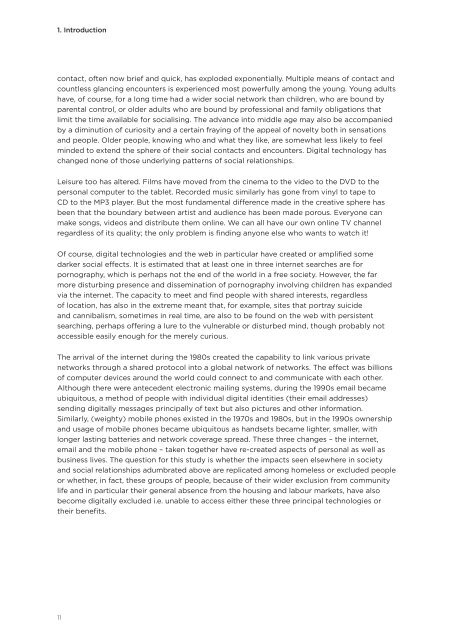Trends and Friends: Access, use and benefits of digital technology for homeless and ex-homeless people
Create successful ePaper yourself
Turn your PDF publications into a flip-book with our unique Google optimized e-Paper software.
1. Introduction<br />
contact, <strong>of</strong>ten now brief <strong>and</strong> quick, has <strong>ex</strong>ploded <strong>ex</strong>ponentially. Multiple means <strong>of</strong> contact <strong>and</strong><br />
countless glancing encounters is <strong>ex</strong>perienced most powerfully among the young. Young adults<br />
have, <strong>of</strong> course, <strong>for</strong> a long time had a wider social network than children, who are bound by<br />
parental control, or older adults who are bound by pr<strong>of</strong>essional <strong>and</strong> family obligations that<br />
limit the time available <strong>for</strong> socialising. The advance into middle age may also be accompanied<br />
by a diminution <strong>of</strong> curiosity <strong>and</strong> a certain fraying <strong>of</strong> the appeal <strong>of</strong> novelty both in sensations<br />
<strong>and</strong> <strong>people</strong>. Older <strong>people</strong>, knowing who <strong>and</strong> what they like, are somewhat less likely to feel<br />
minded to <strong>ex</strong>tend the sphere <strong>of</strong> their social contacts <strong>and</strong> encounters. Digital <strong>technology</strong> has<br />
changed none <strong>of</strong> those underlying patterns <strong>of</strong> social relationships.<br />
Leisure too has altered. Films have moved from the cinema to the video to the DVD to the<br />
personal computer to the tablet. Recorded music similarly has gone from vinyl to tape to<br />
CD to the MP3 player. But the most fundamental difference made in the creative sphere has<br />
been that the boundary between artist <strong>and</strong> audience has been made porous. Everyone can<br />
make songs, videos <strong>and</strong> distribute them online. We can all have our own online TV channel<br />
regardless <strong>of</strong> its quality; the only problem is finding anyone else who wants to watch it!<br />
Of course, <strong>digital</strong> technologies <strong>and</strong> the web in particular have created or amplified some<br />
darker social effects. It is estimated that at least one in three internet searches are <strong>for</strong><br />
pornography, which is perhaps not the end <strong>of</strong> the world in a free society. However, the far<br />
more disturbing presence <strong>and</strong> dissemination <strong>of</strong> pornography involving children has <strong>ex</strong>p<strong>and</strong>ed<br />
via the internet. The capacity to meet <strong>and</strong> find <strong>people</strong> with shared interests, regardless<br />
<strong>of</strong> location, has also in the <strong>ex</strong>treme meant that, <strong>for</strong> <strong>ex</strong>ample, sites that portray suicide<br />
<strong>and</strong> cannibalism, sometimes in real time, are also to be found on the web with persistent<br />
searching, perhaps <strong>of</strong>fering a lure to the vulnerable or disturbed mind, though probably not<br />
accessible easily enough <strong>for</strong> the merely curious.<br />
The arrival <strong>of</strong> the internet during the 1980s created the capability to link various private<br />
networks through a shared protocol into a global network <strong>of</strong> networks. The effect was billions<br />
<strong>of</strong> computer devices around the world could connect to <strong>and</strong> communicate with each other.<br />
Although there were antecedent electronic mailing systems, during the 1990s email became<br />
ubiquitous, a method <strong>of</strong> <strong>people</strong> with individual <strong>digital</strong> identities (their email addresses)<br />
sending <strong>digital</strong>ly messages principally <strong>of</strong> t<strong>ex</strong>t but also pictures <strong>and</strong> other in<strong>for</strong>mation.<br />
Similarly, (weighty) mobile phones <strong>ex</strong>isted in the 1970s <strong>and</strong> 1980s, but in the 1990s ownership<br />
<strong>and</strong> usage <strong>of</strong> mobile phones became ubiquitous as h<strong>and</strong>sets became lighter, smaller, with<br />
longer lasting batteries <strong>and</strong> network coverage spread. These three changes – the internet,<br />
email <strong>and</strong> the mobile phone – taken together have re-created aspects <strong>of</strong> personal as well as<br />
business lives. The question <strong>for</strong> this study is whether the impacts seen elsewhere in society<br />
<strong>and</strong> social relationships adumbrated above are replicated among <strong>homeless</strong> or <strong>ex</strong>cluded <strong>people</strong><br />
or whether, in fact, these groups <strong>of</strong> <strong>people</strong>, beca<strong>use</strong> <strong>of</strong> their wider <strong>ex</strong>clusion from community<br />
life <strong>and</strong> in particular their general absence from the housing <strong>and</strong> labour markets, have also<br />
become <strong>digital</strong>ly <strong>ex</strong>cluded i.e. unable to access either these three principal technologies or<br />
their <strong>benefits</strong>.<br />
11

















